What is a sewer valve for?
In the private sector and multi-storey buildings, they often resort to such a device as a valve on a sewer pipe, which will help in case of sewage flooding by rain, melting snow, as well as in case of force majeure from natural disasters. But such a gadget is not a prerequisite for the equipment of the waste system, it is installed only in cases where the danger of back pressure actually exists, and this depends on various factors. Below we will talk about the system of such protection, installation, conditions, as well as show you the video in this article.
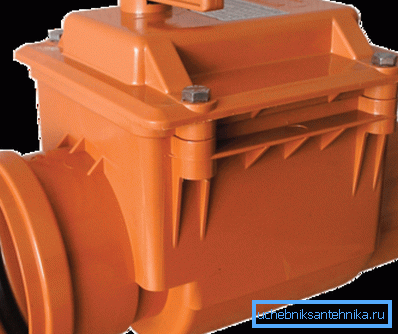
Stop valve
Principle of operation
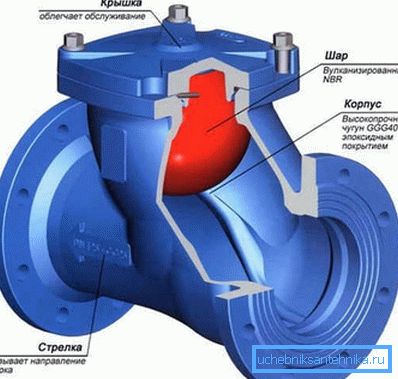
- Valves, similar to the one you see on the top image, are installed on horizontal sewer pipes, and if we talk about housing and utilities, they mount it in the basements of houses. The principle of operation here is quite simple - if water flows in the direction of the arrow, which is on the body, then it lifts the locking ball, which moves along the channel (it can be seen in the figure). In cases where back pressure occurs, the ball simply descends down this channel and locks the pipe in one direction.
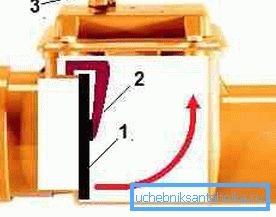
- Exactly the same functionality, but a somewhat different system of constipation has a plastic device, which is also intended for horizontal installation and is sometimes even mounted in a room near the toilet bowl.. This shut-off valve for sewage has a fairly simple device - it is a plastic plate with a rubber gasket (1), which is held on the lever (2) and, moreover, it has a lid for revision (3). With water pressure on the plate in the direction of the arrow on the body, the plate rises on a lever like a hatch, but if back pressure is created, the plate drops and locks the passage.
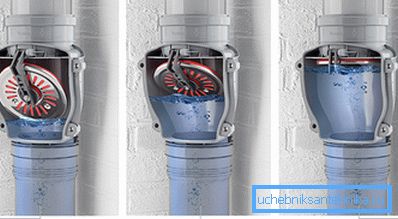
- The vertical sewer valve works in the same way as the horizontal one, where there is a movable plate with a rubber gasket attached on the lever. You can see the cycle of locking the passage under pressure from below. Such a device is used for risers.

- The aerator of the sewage system or, as it is also called, the exhaust breather valve for sewage serves to supply and retain air in the sewage pipe and its main element is a rod or a membrane (depending on the modification). The principle of operation of this device is quite simple - when water is drained, the air in the system is diluted, and the membrane opens slightly, allowing the air outside to restore pressure. After the pressure stabilizes, the membrane closes back.
When it is necessary
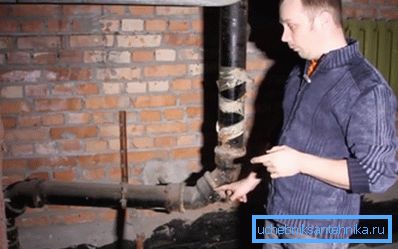
Let's first deal with the apartment in a high-rise building and imagine that we are on the first floor. A sewer riser from all floors descends to the basement or to the technical floor, where it passes from vertical to horizontal plane, and the corner couplings are installed with a smooth turn to avoid blockages, but, nevertheless, this sometimes happens. If a blockage occurs, then the waste water from the upper floors has nowhere to go, and it will rise up through the toilet, bathroom, sink, and so on (the law of communicating vessels).
Note. If the first floor is clogged, the water will rise to the second floor, but overflow will most likely not occur there, since the water column will push the resulting blockage with its mass.
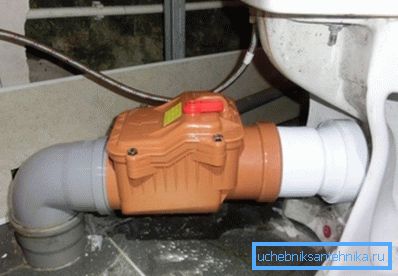
To prevent such extremely unpleasant circumstances, a horizontal or vertical shut-off valve is installed, the main problem of which is its bulkiness. Nevertheless, such protection is necessary, but if you install it on the riser, then it will not give you anything, since the danger lies precisely in pressure from the upper floors, which means that the locking device must crash on the outlet from the riser, as in the top photo. But this option provides for the protection of only one sanitary unit and is appropriate only in cases where there are no other sewage taps for sinks, baths, and so on.
Therefore, in such cases you have two options: the first is to install one non-return valve on the toilet, and the other on the outlet for the remaining bathrooms, and the second is to install one device to the distribution tee on the toilet and the other nodes. As you understand, a lot of space will be taken by both options - in the first case two or even three bulky gadgets, and in the second - you will have to increase the distance from the riser to make a tie-in to the tee (quad) distribution and no instruction will help you here - you need to look for an exit on their own.
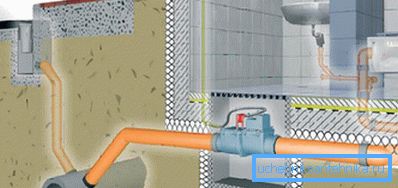
It is somewhat easier to equip such protection in the private sector - even if you have a house on several floors and bathrooms are at all levels, then this is only your problem and no one else - after all, you won’t drain the water from the upper floor when the sewage system is blocked in your house. But to negotiate with neighbors from the upper floors is sometimes practically impossible, if only because they will not be at home at a certain moment.

Therefore, the private sector allows you to mount a locking device of any type - membrane or ball, vertical or horizontal - the most important thing is that it cut to the distribution node. This can be done either on the technical floor (if there is one), or you can equip a special inspection well for the sewer constipation, where you can perform maintenance by cleaning the ball or laying the membrane from the cake. Of course, the cost of such equipment is about a hundred or two hundred times more (depending on the modification) than the price of a tee for a hundredth sewage pipe, but your peace of mind is worth it.
Note. We in this article paid little attention to the air sewer valve, but this is only because we thought that its installation was not as important as the installation of a sewer valve. The aerator is often installed in order to eliminate the noise that occurs when draining from the dilution of air in the pipe, so it does not have much technical value.
Conclusion
Inset into the sewage system of a check valve (vertical or horizontal), as well as an aerator, you can always do it yourself, but you need to pay attention to the arrow on the body, indicating the direction of flow. In technical terms, the installation is similar to all fittings.